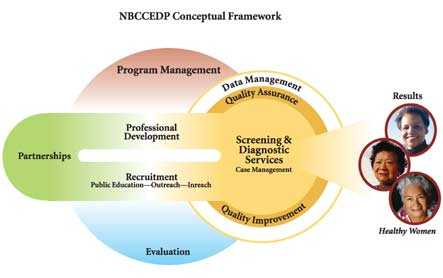The NBCCEDP Conceptual Framework
Definition and Purpose of the NBCCEDP Conceptual Framework

Program Management
Program management and evaluation are represented by a sphere that symbolizes their all-encompassing nature. Program management is placed on top to represent how all other parts of the program fall under this leadership. Managing these components requires a “systems approach”—understanding the bigger picture of how and why the program components interrelate to achieve optimal results.
Screening and Diagnostic Services
Screening and diagnostic services are represented as the core of the program. Providing these services to underserved women is the intent of the program. All other program components are related to and support the delivery of screening and diagnostic services to those most in need.
Data Management
Data management is represented as a circle surrounding screening and diagnostic services, indicating its focus on this component. Collection and analysis of surveillance data, especially the results of the screening and diagnostic services, should be used to inform and evaluate each of the other program components.
Quality Assurance and Quality Improvement
Quality assurance and improvement are represented as an inner circle to show their direct connection to screening and diagnostic services. They work in concert with the data management and evaluation components to monitor, assess, and improve program outcomes. Quality assurance is on top, representing program management’s responsibility to ensure high-quality care. Quality improvement is at the bottom, showing its proximity to evaluation.
Partnerships
Partnerships are represented as an extension to show that they expand the program’s reach, capacity, and resources. Partnerships influence all components, and partners play a key role in advancing the broader goals of the NBCCEDP: enhanced access to high-quality health care for all women.
Professional Development
Professional development is the first of two structural links that directly tie partners to delivery of screening and diagnostic services. Professional development enhances service delivery.
Recruitment
Recruitment is the second of two structural links that directly tie partners to delivery of screening and diagnostic services. Recruitment creates demand from and provides a link to services for women most in need. Recruitment includes educating women about the importance of screening, explaining the services available, and removing their barriers to obtaining these services.
Evaluation
Management and evaluation are represented by a sphere that symbolizes their all-encompassing nature. Evaluation is placed at the bottom to show it is the foundation of successful operation of all components, individually and together.
- Page last reviewed: August 1, 2013
- Page last updated: July 15, 2015
- Content source:
- Maintained By:


 ShareCompartir
ShareCompartir